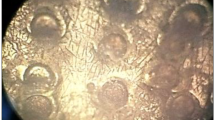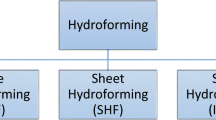Abstract
In the hydroforming of curved sheet parts with a small thickness-diameter ratio, qualified parts are difficult to be manufactured when using the traditional hydroforming process. To solve this problem, double-layer sheet hydroforming was proposed and the wrinkle-free sheet parts were obtained in the authors’ previous study, but the inhibition mechanism of forming defects is far from perfection. Therefore, in this paper, the inhibition mechanism of forming defects is investigated by the combination of FE simulations and technological experiments. Different from the previous research, 2198 Al-Li alloy sheet was selected as the lower sheet. Other conditions such as heat treatment status and thickness are the same as before. The principle of wrinkle elimination can be concluded into the following two aspects. On the one hand, the upper sheet cannot be wrinkled during hydroforming, On the other hand, the surface blank holder pressure is applied in the suspending area. In addition, the beneficial friction between this two sheets changes the radial stress state of the lower sheet and makes the radial strain at some specific area (punch contact area and die corner area) decreased. In conclusion, qualified sheet parts can be manufactured by double-layer sheet hydroforming.
Similar content being viewed by others
References
Miller WS, Zhuang L, Bottema J, Wittebrood AJ, DeSmet P, Haszler A, vieregge A (2000) Recent development in aluminium alloys for the automotive industry. Mater Sci Eng A Struct 280:37–49
Hirsch J, Al-Samman T (2013) Superior light metals by texture engineering: optimized aluminum and magnesium alloys for automotive applications. Acta Mater 61(3):818–843
Bull M (1992) Aluminium sheet alloys for structural and skin applications. SAE Technical Paper Series 920669
Jain M, Allin J, Bull MJ (1998) Deep drawing characteristics of automotive aluminum alloys. Mater Sci Eng A 256:69–82
Halkaci HS, Turkoz M, Dilmec M (2014) Enhancing formability in hydromechanical deep drawing process adding a shallow drawbead to the blank holder. J Mater Process Technol 214:1638–1646
Toros S, Ozturk F, Kacar I (2008) Review of warm forming of aluminum-magnesium alloys. J Mater Process Technol 207(1–3):1–12
Zhang WW, Teng BG, Yuan SJ (2015) Research on deformation and stress in hydroforming process of an ellipsoidal shell without constraint. Int J Adv Manuf Technol 76:1555–1562
Zhang SH, Danckert J (1998) Development of hydro-mechanical deep drawing. J Mater Process Technol 83(1–3):14–25
Lang LH, Wang ZR, Kang DC, Yuan SJ, Zhang SH, Danckert J, Nielsen KB (2004) Hydroforming highlights: sheet hydroforming and tube hydroforming. J Mater Process Technol 151(1–3):165–177
Liu W, Chen YZ, Yuan SJ (2017) Mechanism analysis on thickness distribution of aluminum alloy hemispherical shells in double-sided sheet hydroforming. Int J Adv Manuf Technol 89:2011–2020
Gorji A, Alavi-Hashemi H, Bakhshi-Jooybari M, Nourouzi S, Hosseinipour SJ (2011) Investigation of hydrodynamic deep drawing for conical-cylindrical cups. Int J Adv Manuf Technol 56(9–12):915–927
Liu W, Chen YZ, Xu YC, Yuan SJ (2016) Evaluation on dimpling and geometrical profile of curved surface shell by hydroforming with reconfigurable multipoint tool. Int J Adv Manuf Technol 86:2176
Zhang SH, Wang ZR, Xu Y, Wang ZT, Zhou LX (2004) Recent developments in sheet hydroforming technology. J Mater Process Technol 151:237–238
Lee MG, Korkolis YP, Kim JH (2015) Recent developments in hydroforming technology. Proc ImechE B J Eng Manuf 229(4):572–573
Xu YC, Kang DC, Zhang SH (2004) Investigation of SUS304 stainless steel with warm hydro-mechanical deep drawing. J Mater Sci Technol 20(1):92–93
Geiger M, Merklein M, Celeghini (2003) Sheet and tube hydroforming at elevated temperature. International Conference on Hydroforming (Fellbach/Stuttgart- Germany) 3:259–278
Zhao SD, Zhang ZY, Zhang Y, Yuan JH (2007) The study on forming principle in the process of hydro-mechanical reverse deep drawing with axial pushing force for cylindrical cups. J Mater Process Technol 187-188:300–303
Lin J, Zhao SD, Zhang ZY, Wang ZW (2009) Deep drawing using a novel hydromechanical tooling. Int J Mach Tools Manuf 49(1):73–80
Chen YZ, Liu W, Xu YC, Yuan SJ (2015) Analysis and experiment on wrinkling suppression for hydroforming of curved surface shell. Int J Mech Sci 104:112–125
Zhou BJ, Xu YC (2016) Wrinkle behavior of hydroforming of aluminum alloy double-layer sheets. JOM 68(12):3201–3207
Cui XL, Wang XS, Yuan SJ (2017) Formability improvement of 5052 aluminum alloy tube by the outer cladding tube. Int J Adv Manuf Technol 90:1617–1624
Acknowledgements
The authors wish to express their sincere thanks to all the funding below. The National Natural Science Foundation of China (No: 51375114 & No: U1637209), the National Key Research and Development Program of China (No: 2017YFB0306304) and the Fundamental Research Funds for the Central Universities (HIT.NSRIF.201134).
Funding
This study received funding from the National Natural Science Foundation of China (No: 51375114 & No: U1637209), the National Key Research and Development Program of China (No: 2017YFB0306304), and the Fundamental Research Funds for the Central Universities (HIT.NSRIF.201134).
Author information
Authors and Affiliations
Corresponding author
Ethics declarations
Conflict of interest
The authors declare that they have no competing interests.
Electronic supplementary material
ESM 1
(PDF 3564 kb)
Rights and permissions
About this article
Cite this article
Zhou, BJ., Xu, YC. The effect of upper sheet on wrinkling and thickness distribution of formed sheet part using double-layer sheet hydroforming. Int J Adv Manuf Technol 99, 1175–1182 (2018). https://doi.org/10.1007/s00170-018-2432-9
Received:
Accepted:
Published:
Issue Date:
DOI: https://doi.org/10.1007/s00170-018-2432-9




